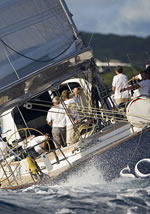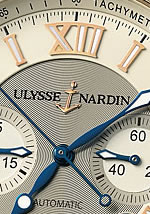 Ulysse Nardin, born in 1823 in Le Locle, Switzerland, was an acomplished watchmaker having first been trained under his father, Leonard-Frederic Nardin and later perfected his skills with two master watchmakers, Frederic William Dubois and Louis JeanRichard-dit-Bressel.
Ulysse Nardin, born in 1823 in Le Locle, Switzerland, was an acomplished watchmaker having first been trained under his father, Leonard-Frederic Nardin and later perfected his skills with two master watchmakers, Frederic William Dubois and Louis JeanRichard-dit-Bressel. Ulysse Nardin, the company, was founded in 1846 and remained under Ulysse's control until his passing in 1876, when his 21-year old son, Paul-David Nardin took over.
Since the founding of the company, Ulysse Nardin was known for their high-quality and high-accuracy craftsmanship, so much so that they became known worldwide for their Marine Chronometers, the most accurate mechanical clocks ever made, achieving a precision of around a tenth of a second per day.
In exhibitions held at various locations, such as Paris, London, Tokio or Buenos Aires, Ulysse Nardin received a total of:
14 Grands Prix (First Prizes)
the "Prize Medal" (1862 - London International Exhibition)
the "Progress Medal"
10 Gold Medals
2 Prix d'Honneur
2 Silver Medals
Until 1967, one second was defined by the rotation of the earth, and because of this, competitive chronometer watches were calibrated and certified in an astronomical observatory. The Observatoire Cantonal de Neuchâtel was the main Swiss observatory where such certifications were done, and in 1975, when the accuracy of mechanical timepieces became irrelevant with the advent of quartz watches, it released a publication regarding the performance of chronometers from 1846 to 1975: of the 4504 certificates awarded in this period, 4324 went to Ulysse  Nardin.
Nardin.
In 1983 Ulysse Nardin was purchased by a group headed by Rolf W. Schnyder, its current president. Mr. Schnyder brought in Dr. Ludwig Oechslin, a scientist, inventor, historian and watch-maker extraordinaire with whom they set out to design and develop complicated timepieces that had never before existed. The first example of this was the Astrolabium, introduced in 1985, part of the Trilogy of Time along with the Planetarium Copernicus (1988) and the Tellurium Johannes Kepler (1992).
The Ulysse Nardin Astrolabium, entered into the Guinness Book of Records in 1989 as the most complicated wristwatch ever made with 21 complications, indicates the position of the sun, the moon and the stars in the sky at any given hour as seen from Earth, as well as sunrise and sunset, dawn and dusk, moonphases, moonrise and moonset, eclipses of sun and moon, the month and the day of the week.





No comments:
Post a Comment